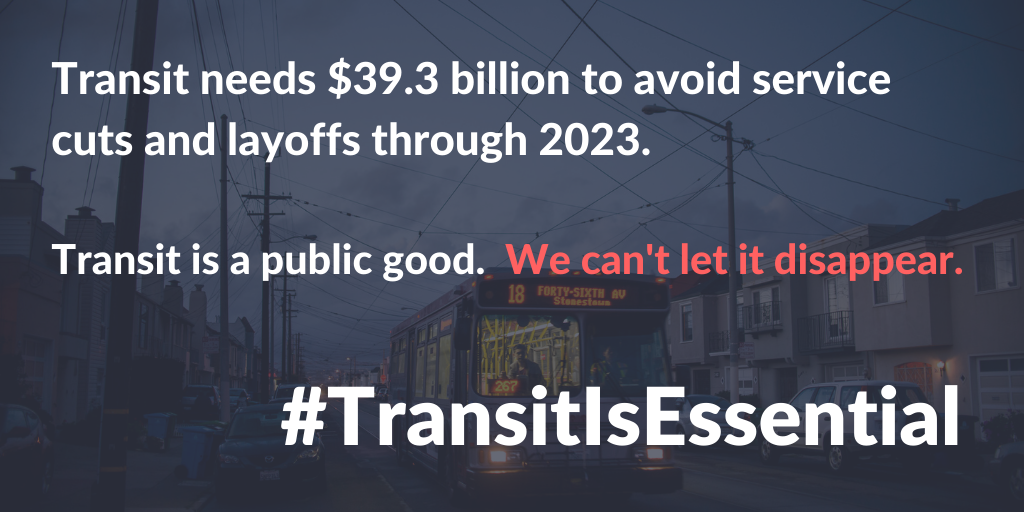
Public transit needs $39.3 billion in the next COVID package

Public transit has been decimated by the pandemic. While the December 2020 COVID package gave transit much-needed support to keep running essential service, this funding will start running out in the spring—as soon as cities and towns prepare to reopen. We urge Congress to provide at least $39.3 billion in emergency relief to prevent transit cuts through 2023.

EDIT, February 11th: On Wednesday night, the House Transportation and Infrastructure Committee approved $30 billion in emergency relief for public transit. We thank the Committee for passing this critical funding and encourage them to provide an additional and much-needed $9.3 billion for transit in subsequent legislation.
Transit is essential to our ongoing pandemic response and our economic recovery. But it’s facing an existential crisis: without additional emergency relief, transit agencies across the country will be forced to make service cuts this spring—just when our cities and towns prepare to reopen.
Public transit needs an additional $39.3 billion in any economic stimulus or relief legislation to preserve transit service though the rest of the pandemic and into the economic recovery. Without this funding, over 2.8 million essential workers who count on transit won’t be able to get to work. These essential workers power healthcare, grocery, sanitation, and other crucial sectors. In addition, millions of Americans—particularly people of color, who make up 60 percent of transit riders—continue to rely on public transportation as an essential connection to jobs, food, healthcare, education, and other critical services.
Why $39.3 billion?
Public transit has been devastated by the pandemic, with ridership losses and declining local revenue sources putting this essential service at risk of near extinction. In fact, transit agencies across the country were planning massive cuts to service and layoffs before the December COVID-19 relief package was passed; the $14 billion in relief from this package delayed these cuts, but without additional robust support, transit agencies will soon be in the same dire situation.
An analysis by TransitCenter found that “without further assistance, some agencies will have to confront service cuts this spring, before cities begin to recover from the pandemic. Other agencies will have to contemplate cuts in the fall, undercutting a fragile economic recovery.” Compounding this financial pressure, transit agencies already face increased costs for cleaning and revenue losses due to COVID-19 that will continue long after the public health crisis is over.
Transit agencies face a projected funding shortfall of $39.3 billion through 2023, according to an independent economic analysis highlighted by the American Public Transportation Association (APTA). Without equivalent relief, “four in 10 agencies will have to consider additional service cuts to close their budget gaps. These cuts would come on the heels of 65 percent of transit agencies having cut service in 2020. Twenty-two percent of agencies will be forced to consider implementing additional layoffs,” according to APTA.
The $39.3 billion ask is in line with the Biden administration’s ask for transit relief. President Biden’s American Rescue Plan calls for $20 billion in relief for transit agencies to survive through summer 2022 without service cuts, which is the size of the budget gap assessed by both APTA and TransitCenter for this year. However, the $39.3 billion goes beyond summer 2022, filling the expected budget gap through 2023.
It’s critical that Congress provides an additional $39.3 billion for public transit in any upcoming economic stimulus or relief legislation. These funds are necessary to preserve essential transit service and support our economic recovery.
If you represent an organization or are an elected official, please sign our letter with the Alliance for a Just Society urging Congressional transportation leaders to include $39.3 billion in emergency relief for public transit in the next COVID-19 relief package.
If you don’t represent an organization or elected official, you can still tweet to get the message out.



